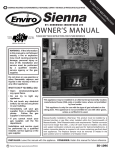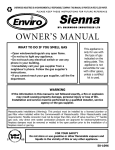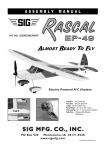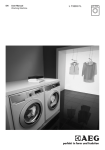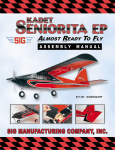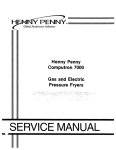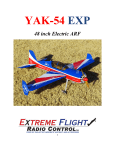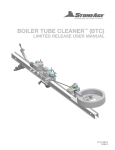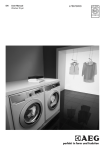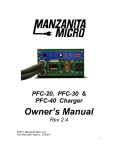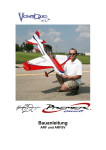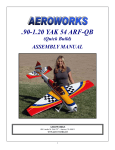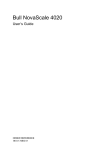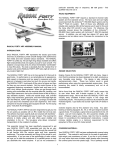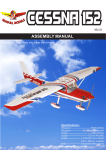Download APC EP Zero ARF Specifications
Transcript
SPECIFICATIONS: (1524 mm) Wingspan: 60 in. (40.6 dm2) Wing Area: 630 sq.in. (1092 mm) Length: 43 in. (2041 - 2267 g) Flying Weight: 4.5 - 5 lbs. Wing Loading: 16.5 - 18.3 oz./sq.ft. (50 - 56 g/dm2) Radio Required: 4 Channel with 4 Standard Servos Electric Power: 500-800 watt Brushless Motor 800-1000kv 60-75 amp Speed Control (ESC) Lipo Battery Pack SIG MFG. CO., INC. PO Box 520 Montezuma, IA 50171-0520 www.sigmfg.com © Copyright 2013, SIG Mfg. Co., Inc. What do those numbers mean? NOTE: This numbering system is very common, however there are exceptions. For instance, some motor manufacturers will list the actual diameter of the stator (armature) inside the motor instead of the case diameter. Some may list the length of the stator inside the motor instead of the case length. Some will give you both if you dig far enough into their specs. Make sure you understand the motor manufacturer’s numbering system when shopping for a motor. INTRODUCTION Congratulations on your purchase of the SIG T-CLIPS EP ARF. We hope you will enjoy this unique fun scale R/C model. Assembly of your T-CLIPS EP ARF is fast and simple when following the detailed instructions in this manual. We urge you to read this assembly manual completely before assembly. Familiarize yourself with the parts and the assembly sequences. The successful assembly and flying of this airplane is your responsibility. If you deviate from these instructions, you may wind-up with problems later on. ❑ MOTOR MOUNT A laser-cut plywood adjustable motor mount is included in this kit. It should work perfectly for any suitable brushless outrunner motor which has an “X” or “cross” motor mount plate on the back. ❑ 60-75 amp ESC (Electronic Speed Control) We used the Castle Creations ICE LITE 75 ESC in all our T-CLIPS prototypes. This is an excellent "switching type" ESC that has a built-in 5amp BEC that is safe to use with a 4 cell lipo battery pack. Good luck with the T-CLIPS. Let’s get started! ADDITIONAL ITEMS YOU WILL NEED TO PURCHASE In addition to this kit, you will need the following items to complete your T-CLIPS and make it flyable. Important Note: BEC (Battery Eliminator Circuit) allows you to use the same battery pack to power both your motor and your radio system, eliminating the normal radio battery pack. When the single battery pack runs down in flight to a prescribed point, the BEC circuit in the ESC will shut down the motor and leave enough power to operate the radio while you land the model. Note that the BEC feature in some cheaper ESCs does not work with 4 cell and larger lipo battery packs - only 3 cell packs. Check the manual of your particular ESC to learn if this is true in your case. If your ESC is only rated for 3 cell operation, you have three options: 1) fly only 3 cell lipo packs (lower power flight performance); or 2) disable the BEC and install a normal receiver battery pack to run the radio full time; or 3) install an aftermarket BEC that is rated for 3 or 4 cells. ❑ RADIO SYSTEM The T-CLIPS requires a standard 4-channel radio system and four standard size servos. In addition, you'll need two 6" long Servo Extension Chords (actual length needed will depend on how long the wires are coming off your servos - be sure to double check your servos and plan accordingly), and one standard Y-Harness Chord for connection of the two aileron servos to the receiver. ❑ 3 or 4 cell 3200-5000 mah LIPO BATTERY PACK You can fly your T-CLIPS with a 3 cell (3S1P) or 4 cell (4S1P) Lipo pack. Pack capacity should be 3200-5000 mah for good flight duration. A 3 cell pack (11.1 volts) provides good flight performance and mild aerobatic capability. A 4 cell pack (14.8 volts) provides more power for full aerobatic performance, and was our favorite. ❑ PROPELLER With electric powered models there are many factors that have a bearing on what propeller to use. The best place to start answering that question is in the instructions that come with your motor. Another fine source of information is one of the electric flight calculators that are available for you to use free online (there is a good one on Castle Creations web site). ELECTRIC POWER SYSTEM ❑ 500-800 watt BRUSHLESS OUTRUNNER MOTOR The T-CLIPS is designed to be powered with a 500-800 watt brushless outrunner motor. This size motor is sometimes referred to as a "32" class motor to those who like to make a comparison to a glow motor. Also, the motor you choose should be rated at 800-1000 kv, in order to turn an appropriate propeller. OUR FLIGHT TEST REPORT After extensive test flying, our favorite setup for the T-CLIPS is a 4250 (case dimensions) 770 kv brushless motor, with a 75 amp ESC, 4S lipo battery pack, and an APC 13 x6.5 E propeller. This combination gave outstanding flight performance. When using a 4S 3200 mah lipo, we had flight times around 6-7 minutes, depending of course on throttle management. A 5000 mah lipo pack provided between 10 to 12 minutes of flight time. Your results may vary. Prop size, size and quality of the battery pack, throttle man- Here is a sampling of motor sizes that work well in the T-CLIPS: 4250-800 4250-770 4248-800 3554-800 2 agement, air temperature, etc., all have a bearing on electric flight performance and flight time. Experiment to find the best combination for your setup. ❑ (4) M4 Split-Ring Lock Washers; for mounting electric motor(4); & main landing gear(3) ❑ (4) M4 Blind Nuts; for mounting electric motor ❑ (4) Nylon Control Horns; for ail(2); elev(1); rud(1) ❑ (12) M2 x 12mm Screws; for control horns ❑ (4) Metal R/C Clevis; for ail(2), ele(1), rud(1) ❑ (4) Nylon Snap Keepers; for ail(2), ele(1), rud(1) ❑ (4) Small pieces of Fuel Tubing; for R/C clevis keepers ❑ (2) 22-3/8" long Wire Pushrods, threaded on one end, including M2 Hex Nuts(2); for elevator & rudder ❑ (2) 7-1/8" long Wire Pushrods, threaded on one end, including M2 Hex Nuts(2); for ailerons ❑ (1) Plywood Battery Tray Assembly ❑ (2) Plastic Cinch Straps ❑ (1) Hook-and-Loop (Velcro®) Strap ❑ (1) Strip of Red Covering Material ❑ BATTERY CHARGER FOR SAFETY AS WELL AS PERFORMANCE, CHARGE LIPO BATTERIES ONLY WITH A LIPO BATTERY CHARGER! In addition to providing the critical charging profile needed to safely charge lipo batteries, a lipo battery charger also includes the capability of "balancing" the available voltage in the cells, ensuring that the battery pack is at peak capacity at the end of the charge cycle. This translates to better flight times and a longer life from the battery pack. REQUIRED TOOLS For proper assembly, we suggest you have the following tools and materials available: A selection of glues - SIG Thin, Medium, & Thick CA Glue CA Accelerator, CA Debonder SIG Kwik-Set 5-Minute Epoxy Screwdriver Assortment Pliers - Needle Nose & Flat Nose Diagonal Wire Cutters Small Allen Wrench Assortment Pin Vise for Small Dia. Drill Bits Hobby Knife with Sharp #11 Blades Small Power Drill With Selection of Bits Dremel® Tool With Selection of Sanding & Grinding Bits Scissors Sandpaper Covering Iron & Trim Seal Tool Masking Tape Paper Towels Alcohol and/or Acetone For Epoxy Clean-up COVERING MATERIAL Your T-CLIPS ARF is covered with ORACOVER®, a premium quality covering made in Germany, and sold in the U.S. by Hanger-9 as Ultracote®. Colors Used On Your Airplane ORACOVER® #23 Ferrari Red (Ultracote® #HANU866) and ORACOVER® #71 Black (Ultracote® #HANU874) COMPLETE KIT PARTS LIST The following is a complete list of all parts contained in this kit. Before beginning assembly, we suggest that you take the time to inventory the parts in your kit. Use the check-off boxes ❑ provided in front of each part description. Please also note that the bolts and nuts required to mount your engine to the motor mounts are not included and must be purchased separately. ❑ (1) ❑ (1) ❑ (1) ❑ (1) ❑ (2) ❑ (1) ❑ (1) ❑ (1) ❑ (4) ❑ (1) ❑ (3) ❑ (2) ❑ (2) ❑ (4) ❑ (4) ❑ (1) ❑ (1) ❑ (4) ❑ (1) ❑ (2) ❑ (1) ❑ (1) ❑ (1) ❑ 4) If sometime in the future you need replacement covering or matching paint for repairs, they are available from your local hobby dealer or online from Hanger-9. How To Tighten Loose Covering After you open your T-CLIPS and take all the covered parts out of their plastic bags, the covering may begin to wrinkle. This is not unusual and is no cause for alarm. Your airplane was built and covered in a part of the world which has relatively high humidity and therefore, the wood was likely carrying a fair amount of moisture. When exposed to drier air, the wood typically loses this moisture, dimensionally "shrinking" in the process. In turn, this may cause some wrinkles. However, wrinkles are easy to remove by just using a hobby type heat iron. Fuselage Right Wing Panel & Aileron, hinges not glued Left Wing Panel & Aileron, hinges not glued Aluminum Tube Wing Joiner M6.5 x 45 mm Nylon Wing Bolts Horizontal Stabilizer & Elevator, hinges not glued Vertical Fin & Rudder, hinges not glued Fiberglass Cowling M3 x 10mm Screws, for cowl mounting Aluminum Main Landing Gear M4 x 20mm Socket-Head Bolts, for mounting landing gear 2-1/2" dia. Main Wheels 4mm dia. Threaded Axles 5mm Hex Nuts; for axles 4mm ID Wheels Collars; for axles Right Fiberglass Wheel Pant Left Fiberglass Wheel Pant M3 x 12mm Socket-Head Bolts, for mounting wheel pants Tailwheel Assembly, including 25mm dia. Wheel, Formed Wire, Nylon Bearing, & Wheel Collars(2) M3 x 12mm Screws; for mounting tailwheel Nylon Rudder Steering Clasp, including M2 x 15mm Bolt and M2 Hex Nut Plywood Electric Motor Mount Assembly Balsa Triangle Stock; for motor mount reinforcement M4 x 16mm Socket-Head Mounting Bolts; for mounting electric motor Caution: Trying to remove the wrinkles by hastily going over them with a heat gun can lead to more problems. You should take your time to carefully go over the entire model with a covering iron, as we will describe. We suggest using a model airplane covering iron for this process. Cover the iron's shoe with a thin cotton cloth, such as an old tshirt, to prevent scratching the covering as you work. 3 After covering your iron, the next step is to set the iron to the correct temperature. This is critical for achieving a good result! The iron should be set to about 220OF - 250OF (104OC - 121OC) as measured on the bottom of the iron using a thermometer. WING ASSEMBLY The wings are designed as a 2-piece system, with separate right and left wing panels joined by an aluminum tube Wing Joiner and a hardwood locating Pin at the rear. Due to the high strength of the wing joiner tube, the wing panels do not need to be permanently glued together. Gluing them permanently together is optional - your call. The obvious benefit to leaving the wing panels separate is the fact that they can be easily transported or stored, requiring a minimum of space. If you do not have a thermometer, you can find the correct temperature by trial and error. Set your iron to a medium setting. Glide the iron over some of the covering that is over solid wood, such as the sheeted wing center section. Observe the covering to see if any bubbles appear. If bubbles appear, the covering is getting too hot! Turn down the temperature of the iron and repeat the test. To help protect your wings during the following steps we recommend that you cover your work surface with a soft cloth or piece of foam. If no bubbles appear, turn up the heat slightly and repeat the test. Keep adjusting until you “zero in” on the correct temperature. Find the temperature that will get the covering to stick down without forming bubbles or causing the seams to pull away. INSTALLING THE AILERON SERVOS For the following steps you will need: (1) Right Wing Panel (1) Left Wing Panel (1) Aluminum Tube Wing Joiner (2) Servos with Mounting Screws (not furnished) (2) 6” Servo Extension Chords (not furnished) (1) Servo Y- Harness (not furnished) Once your iron is set to the correct temperature, go over the entire framework of the airplane, making sure that the covering is securely bonded to the structure everywhere the covering comes in contact with the wood underneath. This takes some time, but is worth the effort. ❑ 1) Mount the aileron servos in the bottom of each wing panel. a) The servo bays are precut for you but you’ll want to double check the covering around the cutout to make sure it is sealed down tight. b) Install the rubber grommets and brass eyelets (supplied with your radio system) into each aileron servo. c) Install the control arms on the two aileron servos. The arms should be at 90 degrees to the servo when the aileron control stick on the transmitter is in neutral and the transmitter trims are in neutral as well. d) Before installing the aileron servos in the wing panels you must attach a servo extension chord to the aileron servo wire. The typical combined length required is approximately18”. A 6” extension chord will usually provide sufficient length. Plug the servo plug into the extension chord and tape the plugs together for added security. After you have all the covering secured onto the solid areas, turn the temperature of the iron up to approximately 300OF - 320OF (149OC - 160OC). This is the correct temperature for shrinking the covering material. Use the iron to tighten up any wrinkles in the “open” areas of the model (no wood underneath the covering). Glide the iron over the wrinkle for a few seconds, then remove. Repeat until the covering is tight with no wrinkles. If wrinkles keep coming back on the tail surfaces, you may need to “ventilate” the areas between the ribs. Otherwise the air that is sealed in those relatively small areas will expand when the heat is applied and actually cause the covering to stretch instead of shrink. Use a pin to poke a tiny hole in the covering between each rib, on the bottom of the part. That will let the expanding air escape and the covering to shrink properly. e) Holding the wing panel with the wingtip UP, drop the end of the extension chord into the servo mount cutout and then thru the openings in the wing ribs, working it towards to the center end of the wing panel. The plug on the end of the extension chord will occasionally get hung up on the ribs, however by turning or gently shaking the wing panel you can get it to fall through the openings in the ribs, until it emerges at the end rib. Once you’ve got the plug to the end rib, direct it through the round hole in the bottom surface of the wing panel. By that time, the servo itself should be next to the servo mount cutout and ready for mounting. f) Fit the servo into the servo mount in the wing panel, (note that the servo is positioned so that the servo arm is at the forward end toward the wing leading edge). Take up any slack in the servo chord as you insert the servo in the mount. Use a pin vise and a small drill bit to drill small pilot holes in the servo mount for the servo mounting screws. Use the screws supplied with your radio Caution When Using Heat Guns: You can also use a hobby-type heat gun to shrink the covering, but you must be careful around seams or color joints. Getting too much heat on the seams may cause them to "creep" or come loose. You must also be careful when using a heat gun when working around the windshield and side windows - heat will distort the clear plastic material. Recommended Temperatures: To adhere the covering - 220OF - 250OF (104OC - 121OC) To shrink the covering - 300OF - 320OF (149OC - 160OC) NOTE: In this manual, any references to right or left, refer to your right or left as if you were seated in the cockpit of the airplane. 4 system to mount the servo in place on the servo mount. Repeat this procedure to mount the servo in the opposite wing panel. Keep a rag handy to wipe off any excess Thin CA glue. (If you get some glue smears on the plastic covering, don't worry about them right now. Once all the hinging is done, you can clean the smears off the covering with CA Debonder). f) Let the glue dry 10-15 minutes before flexing the hinges. At first you might notice a little stiffness in the joint. This will go away after the hinges have been flexed back and forth a couple dozen times. INSTALL AILERON CONTROL HORNS & PUSHRODS From the kit contents locate: (2) Nylon Control Horns (6) M2 x 12 mm Screws (2) Short Pushrod Wires with M2 Hex Nut (2) Metal R/C Clevis (2) Nylon Snap Keepers (2) small pieces of Fuel Tubing HINGING THE AILERONS ❑ 2) Note that the CA Hinges are installed, but not yet glued, in the ailerons and wing panels. The installation process for the hinges is the same for all of the control surfaces on this model. a) If you removed the ailerons and hinges from the wing panels when you tightened the covering material, reinstall them now. First insert the five CA Hinges into the slots in the aileron. Put two pins in the center of each hinge, up against the leading edge of the aileron, to keep the hinges centered during the next step. ❑ 3) Look closely and you will see three holes pre-drilled in the bottom of the ailerons for mounting the nylon control horns. Screw the control horn in position on the bottom of the aileron using three M2 x 12mm screws. When the tips of the screws begin to emerge at the top surface of the aileron, add the control horn's nylon retaining plate. The aileron will be sandwiched between the control horn on the bottom and the retaining plate on the top. Continue turning in the screws until the horn and retaining plate are snug against both surfaces of the aileron. Do not over tighten the screws and crush the wood. b) Now carefully insert the exposed portion of the five hinges into the trailing edge of the wing. You will find it easiest to slide the hinges into the slots at angle, one hinge at a time, instead of trying to push it straight onto all the hinges at once. c) Adjust the aileron so that the tip of the aileron is flush with the wing tip. The ailerons should be tight against the pins in the hinges to minimize the gap between the wing and the aileron. The aileron is now in the proper position for permanently gluing them in place with thin CA glue. d) Flex the aileron down and hold it in this position. Remove the pins from one hinge and then carefully apply 3-4 drops of Thin CA glue directly onto the hinge in the gap. You will notice that the glue is quickly wicked into the slot as it penetrates both the wood and the hinge. We suggest using a fine tipped applicator on the glue bottle to better control the flow of glue. The excess length of the screws that is extending past the retaining plate can be cut off with a pair of side cutting pliers or ground down with a rotary tool with a cutoff disc. ❑ 4) Next assemble and install the aileron pushrods. a) Slide a short piece of Fuel Tubing onto the small end of the Metal R/C Clevis. Screw the Hex Nut on the Aileron Pushrod Wire all the way up to the end of the threads. Then screw the metal clevis halfway onto the threaded end of the Aileron Pushrod Wire. b) Clip the metal clevis into the last hole in the nylon control horn. Lay the other end of the pushrod wire over the outer hole in the servo arm. Use a felt tip pen to mark the wire where it e) Turn the part over and glue the other side of the hinge. Continue this process until you have glued both sides of all the hinges! 5 crosses the hole. Use a pair of pliers to put a sharp 90-degree bend in the wire at the mark. FUSELAGE ASSEMBLY INSTALL THE MAIN LANDING GEAR Locate the following parts from the kit contents: (1) Fuselage (2) Aluminum Main Landing Gear (3) M4 x 20mm Socket-Head Bolts (3) M4 Split-Ring Lock Washers (2) 2-1/2" dia. Main Wheels (2) 4mm dia. Threaded Axles (4) 5mm Hex Nuts; for axles (4) 4mm ID Wheels Collars; for axles (1) Right Fiberglass Wheel Pant (1) Left Fiberglass Wheel Pant (4) M3 x 12mm Socket-Head Bolts NOTE: We suggest you use a thread locking liquid (like Locktite®) on all bolts and nuts used in the assembly of the landing gear. c) Insert the bent end of the pushrod into the servo arm, from the top. Note: You will most likely need to use a 1/16” dia. drill to open the hole in the servo arm to accept the pushrod wire. d) Mark and cut off the excess end of the pushrod wire, leaving 1/8” of wire protruding below the bottom of the servo arm. e) Clip a Nylon Snap Keeper in place on the servo end of the pushrod wire. Snap the free end of the keeper up and over the protruding end of the pushrod wire, underneath the servo arm. ❑ 5) Install a Threaded Axle into the large hole of the landing gear leg, with the plain end of the axle shaft pointing to the outside. Secure the axle with the two 5mm Hex Nuts. When tightening the nuts, keep the flats of the nut on the axle side of the gear leg parallel to the front edge of the leg - see photo. This allows the hex nut to fit inside the narrow notch in the wheel pants when they are added later. f) Check that the aileron servo is in neutral position and adjust the metal clevis as needed to get the aileron in neutral position. ❑ 6) Slide a 4mm Wheel Collar onto the axle shaft, but leave approximately 1/16” of space between it and the nut, to provide proper spacing of the wheel in the wheel pant. Tighten the wheel collar set screw securely. VERY IMPORTANT CORRECT NEUTRAL POSITION FOR T-CLIPS AILERONS Adjusting the neutral position of the ailerons of the T-CLIPS is a bit different than most models, due to the T-CLIPS unique airfoil shape. The T-CLIPS airfoil is flat on the bottom from the main spar back to the trailing edge of the wing panel. DO NOT line the aileron up with this flat bottom portion of the airfoil. That would set the both ailerons too high and be detrimental to the flight characteristics of the airplane. The center line of the ailerons must be lined up with the center line of the airfoil, as shown in this drawing. ❑ 7) Next slide one of the Main Wheels onto the axle and test to make sure it spins freely. If it does not turn freely, drill out the plastic hub of the wheel with an 11/64" or #17 drill bit. ❑ 8) Slide a second Wheel Collar onto the axle and up to the wheel. Leave a small gap between it and the wheel, so the wheel will turn freely, and then tighten the wheel collar set screw. g) Once the ailerons are properly adjusted, insure that the metal clevis can’t open up and come loose from the control horn by sliding the piece of Fuel Tubing over the arms of the clevis. Also tighten the M2 Hex Nut up against the back of the clevis. ❑ 9) Check the orientation of the landing gear to make sure you know which way is forward. The two outer holes for mounting the gear to the fuselage go to the front. Test fit the wheel pants over 6 the wheels and line up the predrilled mounting holes. Secure the wheel pants in place with two M3 x 12mm socket head bolts on each pant. ❑ 13) Bolt the wing in place on the fuselage with the Nylon Wing Bolts provided. Then pin the stabilizer and elevator assembly in place on the fuselage. It's time to check the alignment of the stabilizer to the wing. a) First view the model from directly in front. Check to see if the stabilizer is level with the wing. You should find it to be very close. If necessary use a sanding block to fine tune the stabilizer platform to level the stabilizer to the wing. b) Next use a tape measure to measure the distance from each stab tip to the back edge of the wing - the distance should be equal on both sides. Adjust if necessary. When you are satisfied with the alignment, proceed to the next step ❑ 14) The horizontal stabilizer is now glued in place into the rear of the fuselage. We suggest using slow drying epoxy glue for this job to allow time to position the stab accurately and make any final adjustments that might be needed. Apply the glue to both sides and reset the stab in place. Use pins to hold it in place. Recheck the alignment. Wipe away any excess epoxy with rubbing alcohol and a soft paper towel. Allow the glue to set completely. ❑ 10) Using three M4 x 20mm Socket-Head Bolts and three M4 Split-Ring Lock Washers attach the landing gear to the fuselage. TAIL SURFACE INSTALLATION For the following steps you will need: (1) Fuselage (1) Wing (1) Stabilizer & Elevator set. (1) Vertical Fin & Rudder Set (2) M6.5 Nylon Wing Bolts (1) Tailwheel assembly, including Wheel and Wheel Collars (2) M3 x 12mm Screws (1) Nylon Rudder Steering Clasp with Bolt and Hex Nut (2) Nylon Control Horns (6) M2 x 14mm Sheet Metal Screws ❑ 15) Pull the Fin and Rudder off their hinges and set the rudder aside for now. Test fit the fin in place on top fo the fuselage and stabilizer. Check to see that the fin sits flush and perpendicular to the stabilizer. ❑ 16) Glue the fin in place using slow drying epoxy glue. Apply a thin coat of glue to the bottom of the fin and to the exposed wood on the stab. With the fin in place, sight the model from the front ❑ 11) Just like the aileron hinges, the elevator hinges are factory installed, but not yet glued. Hinge the elevator assembly to the stabilizer, using the same techniques you did for the ailerons refer to page 5 of this manual. Let the hinges dry adequately before proceeding. ❑ 12) Look closely and you will see three holes pre-drilled in one of the elevators for mounting a nylon control horn. Screw the control horn in position on the bottom of the right elevator, using three M2 x 12mm screws. When the tips of the screws begin to emerge at the top surface of the elevator, add the control horn's nylon retaining plate. Continue turning in the screws until the horn and retaining plate are snug against both surfaces of the elevator. Do not over tighten the screws and crush the wood. 7 to make sure the fin is absolutely 90 degrees upright to the stab. If needed, use a little masking tape to hold it in alignment. Wipe off any excess glue rubbing alcohol and a soft paper towel. RADIO INSTALLATION For this section you will need: (1) Radio Receiver (not furnished) (2) Servos with Mounting Screws (not furnished) (1) Plastic Cinch Straps ❑ 17) Hinge the rudder to the fin and the rear of the fuselage using the same techniques you did for the other hinges - refer to page 5 of this manual. Make sure to line up the top of the rudder flush with the top of the fin. This will ensure the tail wheel bracket lines up correctly. Let the hinges dry adequately before proceeding. ❑ 22) Install the rudder and elevator servos inside the fuselage in the built-in plywood radio mounting tray. Note that the rudder servo goes on the right side of the airplane, and the elevator servo goes on the left side. Be sure to drill pilot holes through the plywood tray for the mounting servo mounting screws. ❑ 18) Look closely and you will find three holes pre-drilled near the bottom of the rudder for mounting a nylon control horn. Install the control horn on the left side of the rudder, with the retaining plate on the right, using three M2 x 14mm screws. ❑ 23) Secure your receiver on the front of the plywood radio tray with one of the plastic cinch straps provided. It’s best to use a piece of foam rubber between the receiver and the plywood. Also, don’t tighten the cinch strap too snug - just enough to keep the receiver in place. TAILWHEEL INSTALLATION ❑ 19) Mount the Tailwheel assembly in place on the lower rear end of the fuselage, using two M3 x 12mm screws. Note that there are two pilot holes already in the fuselage for the screws. NOTE: If you are not using BEC, but are instead using a separate receiver battery, you can mount your on/off switch by cutting a hole in the fuselage side. ELEVATOR & RUDDER PUSHROD INSTALLATION For this section you will need: (1) Fuselage (2) Long Pushrod Wires with M2 Hex Nut (2) Metal R/C Clevis (2) Nylon Snap Keepers (2) small pieces of Fuel Tubing ❑ 24) Assemble and install the elevator pushrod. a) First slide a small piece of Fuel Tubing onto the small end of the Metal R/C Clevis. Next screw the Hex Nut that is on the Pushrod Wire all the way up to the end of the threads. Then screw the metal clevis halfway onto the threads. ❑ 20) Adjust the wheel collar shown to set the height of the tailwheel wire. Then check to see if the long steering leg of the tailwheel wire is parallel to the bottom of the rudder. The wire may need to be tweaked slightly to make it parallel. ❑ 21) Slide the Nylon Rudder Steering Clasp onto the bottom of the rudder and onto the tailwheel wire at the same time. Locate the clasp at the halfway point on the wire, and then drill a hole for the M2 x 15mm Bolt. Insert the bolt through the hole and tighten down the M2 Hex Nut to clamp the bracket in place. b) Locate the pre-cut pushrod exit hole for the elevator on the right side of the fuselage at the back of the plane. Slide the pushrod into the exit hole and inside the pushrod sleeve built into the fuselage. Slide it in until you can clip the clevis into the middle hole of the control horn. Lock the elevator in neutral position with tape, or with two small balsa wood sticks held together with small rubber bands. 8 c) Inside the fuselage, hold the pushrod wire over the elevator servo output arm and mark the wire where it crosses over the outer hole in the servo arm. ❑ 25) Locate the pre-cut pushrod exit hole for the rudder on the left side of the fuselage at the back of the plane and repeat step 24) in its entirety to install the rudder pushrod. ELECTRIC MOTOR & ESC INSTALLATION For this section you will need: (1) Fuselage (1) Plywood Electric Motor Mount (1) Balsa Triangle Stock (4) M4 x 16mm Socket-Head Bolts (4) M4 Split-Ring Lock Washers (4) M4 Blind Nuts (1) Plywood Battery Tray (1) Hook-and-Loop Tape (Velcro®) (1) set Electric Motor, ESC, Prop, Lipo Battery (not furnished) NOTE: The mounting of the electric motor in the T-CLIPS assumes that your motor has a typical "X" or "cross" mounting plate on the back of the motor. d) At the tail end, unlock the elevator from neutral position, and then unclip the clevis from the control horn. Remove the clevis and the hex nut completely off of the pushrod and set them aside. Now pull the pushrod out of the fuselage from the servo end. It will be easier to complete the next three steps with the pushrod out of the airplane. e) Cut off the pushrod wire 1/4” past the mark made at the servo end in step c). Then put a sharp 90-degree bend in the wire at the mark. f) Remove the servo arm from the elevator servo. Drill out the last hole in the servo arm with a 1/16" dia. drill so it will accept the pushrod wire. Then insert the bent end of the pushrod wire into the servo arm, from the top. g) Clip a Nylon Snap Keeper in place to hold the pushrod wire in the servo arm. Snap the free end of the keeper up and over the protruding end of the pushrod wire, underneath the servo arm. ❑ 26) Notice that the firewall portion of the laser-cut plywood motor mount is adjustable fore and aft to accommodate different length motors. The length of the motor mount can be set between 1.7" to 2.1". Next we will determine where you should set it. ❑ 27) Assemble your motor according to the manufacturer's instructions. Then carefully measure the distance from the back of the mounting plate to the front of the thrust washer*. * The “thrust washer” is the part of the prop adaptor where the back of the propeller will be located. h) Now slide the pushrod back inside the pushrod sleeve in the fuselage, from the front. When it is in far enough, put the servo arm back in place on the servo. i) Make sure that the elevator servo is in neutral position and then adjust the metal clevis at the tail end as needed to get the elevator in perfect neutral position. j) After the elevator is properly adjusted, insure that the metal clevis can’t open up and come loose from the control horn by sliding the small piece of fuel tubing over the arms of the clevis. Also tighten the M2 Hex Nut up against the back of the clevis. 9 ❑ 28) For the T-CLIPS, we need a finished distance from the back edge of the motor mount to the motor’s thrust washer to end up exactly 4-1/2”. This is important so the cowling will fit properly. a) So what you need to do is to subtract the measurement taken in the previous step (27) from 4-1/2”. The result is the distance you need to set the front of the firewall from the back edge of the plywood motor mount box. (With the motor we are using in these photos, the motor measurement is 2-1/2”. So 4-1/2” minus 2-1/2” = 2”. Your result may be different depending.) b) Next carefully measure and mark the distance determined in the previous step from the back edge of the motor mount box towards the front. Do this along side each of the adjustment slots on both sides of the box (four marks total). c) After you have all four slots marked, carefully align the front face of the firewall to line up with the marks. Make sure you end up with the firewall straight and square in the box. If it is not, recheck your marks and adjust as necessary. d) Tack glue the firewall in place. Recheck once more to make sure that the front of the firewall is at the correct distance from the back of the motor mount box. That distance plus the length of your motor must equal 4-1/2”. When satisfied it is correct, glue the firewall securely to the rest of the motor mount box. ❑ 31) Trial fit the motor mount box onto the front of the fuselage, inserting the tabs on the back of the box into the slots in the fuselage former. The box must fit tight against the former all the way around with no gaps. If there is anything (like a gob of dried glue) keeping the box from fitting up tight against the former, clean it up now. When it fits properly, glue the motor mount box permanently in place on the fuselage. We prefer epoxy glue for this. ❑ 29) Mount your motor to the front of the firewall using the M4 Socket-Head Bolts, Lock Washers, and Blind Nuts provided. a) On the front face of the firewall you will find four lines etched into the plywood at 45 degrees. Use a sharp pencil and a straight edge to extend these lines out to the edges of the firewall. b) Set your motor in place on the firewall and carefully line up the four motor mounting holes with the four 45 degree lines. Once you are sure the motor is centered properly, mark the mounting holes with a pencil. Remove the motor and drill out the mounting holes with a 7/32" dia. drill bit. c) Install the four M3 blind nuts in the holes, on the back side of the firewall. Put a couple drops of medium CA glue on the flanges of the blind nuts to secure them to the plywood, but be careful not to get any of the glue in the threads. d) Finally bolt your motor in place on the firewall. ❑ 32) Install your Speed Controller (ESC) a) Solder appropriate connectors (not supplied) to the battery leads of your ESC. b) Mount your ESC onto the plywood tray right behind the firewall, using one of the plastic cinch straps provided. Or if you prefer you can mount the ESC with double-sided servo tape or Velcro® tape (neither of these are provided). ❑ 30) Locate the piece of balsa triangle stock provided. Measure, cut and install pieces to reinforce the all corner joints inside the motor mount box. Use Med or Thick CA glue for this job to ensure a good bond and gap filling. 10 c) Run the ESC's servo chord back to the receiver and plug it in. Use a few pieces of tape can hold the chord against the inside wall of the fuselage and out of the way of the slide-in battery tray. the top of the tab, which is putting up pressure on the tray. Once the tray is all the way down the slide, the tab should snap into the matching notch near the top end of the tray. d) Connect the ESC's motor wires to the motor. Operate the motor and check the direction of rotation. Always do this without a propeller attached! If you need to reverse the rotation, refer to the instructions that came with the motor and ESC. Most likely the battery tray will be hard to slide in the first time. If it seems extremely tight and almost impossible to slide the battery tray in, take a sanding block and sand a few thousands of an inch off the top surface of the locking tab. Then try sliding the tray in again. Don't sand off very much off of the tab at a time. Work on it slowly, until you can slide the tray in place without having to use excessive force. The tab is intended to push up on the bottom of the tray until it snaps into the notch, once the tray is all the way in. SAFETY ISSUE: We strongly recommend the use of an “arming switch” for your motor installation. With an arming switch you can install your battery pack in the airplane and hook up the wires without danger of the motor starting. The arming switch keeps the electricity away from the motor until you “arm” it when you are ready to takeoff. The most common arming switches are a simple external plug that puts a break in the positive battery lead to the motor, such as the Maxx Products Arming Switch shown below. There are also arming switches built into some of the advanced ESCs now on the market. If you can slide the battery tray in almost all the way, but it doesn’t want to go the last fraction of an inch, most likely the bottom edge of the tray is hanging up where it is starting to enter the bottom track. Use a sanding block to bevel and round the bottom edge of the tray slightly, to allow it to slip into the bottom track. ❑ 33) The T-CLIPS plywood Battery Tray slides into tracks that are built into the fuselage. Inspect these parts to familiarize yourself with how the tray system works. In addition to the two tracks on each side of the fuselage, notice that there is a small wood tab sticking up at the top of the slide. ❑ 34) A 2” wide x 6” long piece of hook-and-loop tape (commonly called Velcro®) is supplied for use on the battery tray. The “hook” side has double-coated foam tape installed on it. Peel the protective paper off the foam tape, and then stick it in place on the plywood Battery Tray. Make sure the tape does not extend past the side boards at the bottom end of the battery tray. Put a strip of the mating “loop” tape (the fuzzy side) on the bottom of each of your battery packs. Make sure it is large enough to keep the battery pack in place during aerobatic flight. This tab will lock into the notch at the top end of the battery tray, once the tray is slid all the way down in the tracks. Due to the tight tolerances, the Battery Tray may require a little bit of hand fitting. Trial fit the battery tray into the track in the fuselage. The idea is for the battery tray to slide down the tracks while it is sliding over 11 do not have access to such a power tool, you can cut the opening with a drill, a hobby knife, and a sanding block - by first drilling a series of almost touching holes inside the pattern lines (1/8” dia. works well); then using the knife to cut through the connecting material between each hole; and finally finishing the edges of the opening with the file or a sanding block. COWLING INSTALLATION For this section you will need: (1) Fuselage (1) Fiberglass Cowling (4) M3 x 10mm Screws ❑ 35) Mount the cowling on the fuselage with the four M3 x 10mm Screws provided. Notice that the holes for the four cowl mounting screws are already pre-drilled in the cowling - two on each side. a) First test fit the cowling in place on the fuselage. As you pass it over the motor, make sure all the wires are out of the way. Carefully adjust the exact position of the cowling. Make sure you have adequate clearance between the front of the cowl and the back of the propeller, and that the prop shaft is centered in the hole. Use a low tack tape to hold the cowling securely in place for the next step. b) Use a 5/64" or #45 bit to drill a pilot hole for the top left cowl mounting screw. Center the drill in the hole in the cowling and drill into the fuselage side. Install an M3 x 10mm screw in the pilot hole - do not over-tighten the screw. c) Recheck the position of the cowling and make any adjustments needed to get it back in perfect position, securing the tape to hold it in place. d) Now drill another pilot hole for the upper screw on the other side of the cowling. Install the screw. e) Repeat this process to install the two bottom cowl mounting screws. Remove all the tape. Optional: In addition to making the new opening at the bottom of the cowling, you may decide after test flying that your ESC or battery pack could use some additional cooling. We have not yet found that to be necessary with our prototype T-Clips, but it could happen in some cases with different motors, props, etc. If you want more airflow over the ESC and battery, the best option is to make a single air exit hole in the bottom of the fuselage, back near the tail. It does not have to be very big. A small oblong slot, or a 1/2” dia. hole can do a lot of good for fuselage cooling. ❑ 37) Mount a suitable propeller on your motor. Be sure to balance the prop before installation. CONGRATULATIONS! Your T-CLIPS EP is completely assembled. However, it is NOT ready for flight! There are a few very critical pre-flight tasks we must perform before flying. These are extremely important and should be approached with patience and care. PRE-FLIGHT BALANCE Balancing your airplane may be the single most important step in preparing it for flight. All airplanes, model or full-size, must be accurately balanced in order to fly successfully. An airplane that is not properly balanced will be unstable and will most likely crash. NOT ALL T-CLIPS WILL BALANCE THE SAME It is impossible to produce a model airplane kit that will automatically have the correct balance point. Not everyone uses the same motor or radio gear - and all those items can vary in weight! Even propellers of the same size can vary as much as a 3/4 oz. between different brands. That’s why every model must be balanced before flying. Don’t feel that whatever the balance point your model came out at is “good enough”. Check carefully and make whatever adjustments are required. Trying to fly an out of balance model is dangerous! ❑ 36) COOLING IS IMPORTANT! With a fully cowled motor, it is very important to make sure your power system is getting proper cooling. Air flowing into the front of the cowling must have a place to exit the cowl. In fact it’s best to have more air exit area than inlet area to create a positive air flow through the cowling - an actual suction effect - drawing the heated air out of the cowling so that more cool air can come in. This positive air flow keeps your motor running cool. We recommend that you make a simple but scale-like opening at the bottom rear edge of the cowling as shown, to provide additional air exit area. Preliminary: All the parts and components that will be in the airplane in flight must be installed in their correct positions. This includes all the radio gear, the propeller, battery pack, etc. Every piece of essential equipment must be installed, ready for flight. ACCEPTABLE BALANCE RANGE FOR T-CLIPS is from 2-3/4" to 3-1/2" AFT OF THE LEADING EDGE OF THE WING The following table lists several acceptable measurements and the equivalent percent of MAC (Mean Aerodynamic Chord). DISTANCE % MAC 2.75" = 26% 2.98" = 28% 3.19" = 30% 3.50" = 33% Note: A Dremel® Tool, or similar powered rotary hand-tool, with an assortment of sanding bits is without a doubt the best tool to use for making cutout in the fiberglass cowling. However, if you A balance point approximately 3” aft of the leading edge (which is at the main wing spar) is ideal for initial test flights. After test flying you can adjust the balance point to fit your flying style. 12 CONTROL SURFACE TRAVEL The following control surface data has been flight tested with the T-CLIPS. However these numbers are only recommended as a starting point. Your flying style may dictate changes. your airplane. Take the time to solve any power system problems before you try to fly. LOW RATES Elevator 3/4" up 3/4" down 40%-50% expo Ailerons 3/8" up 3/8" down 40%-50% expo Rudder 1-1/4" right 1-1/4" left 25%-40% expo Always make it part of your pre-flight routine to check each control on the airplane, making sure the surfaces are moving in the correct directions. Also check each control linkage to be sure they are secure and that nothing is loose. With all the controls checked, make a range check with your radio system, making sure everything is working perfectly. HIGH RATES Elevator 1-1/4" up 55%-70% expo 1-1/4" down Ailerons 5/8" up 5/8" down 55%-70% expo Rudder 2" right 2" left 50% expo High Rate Throws High rate control throws are only meant for extreme aerobatics not for normal flying. You should be competent and comfortable flying your T-CLIPS with normal control throws before attempting high rates. Exponential: You will find lots of opinions about the proper amount of exponential travel to use on each control surface in both low and high rate settings. The best aerobatic pilots in the world agree that you will want more expo at high rates than at low rates. After test flights adjust your settings as needed to obtain the control feel you want. Consult your radio manual to find out how to adjust the exponential settings of your transmitter. FLYING When it comes to test flying a new model, we always advise modelers to choose a calm day with little or no wind. These conditions allow you to better evaluate and more accurately adjust the trim requirements for your airplane. As we’ve mentioned before, a good running, reliable motor is a must for the ultimate success of We hope that your T-CLIPS will provide you with many enjoyable hours of flight. Good luck and safe flying! 13 WARNING! THIS IS NOT A TOY! CUSTOMER SERVICE Flying machines of any form, either model-size or full-size, are not toys! Because of the speeds that airplanes must achieve in order to fly, they are capable of causing serious bodily harm and property damage if they crash. IT IS YOUR RESPONSIBILITY AND YOURS ALONE to assemble this model airplane correctly according to the plans and instructions, to ground test the finished model before each flight to make sure it is completely airworthy, and to always fly your model in a safe location and in a safe manner. The first test flights should only be made by an experienced R/C flyer, familiar with high performance R/C aircraft. SIG MFG. CO., INC. is committed to your success in both assembling and flying the RASCAL 72EG ARF. Should you encounter any problem building this kit or discover any missing or damaged parts, please feel free to contact us by mail or telephone. SIG MFG. CO., INC. P.O. Box 520 401 South Front Street Montezuma, IA 50171-0520 JOIN THE AMA PHONE: 1-641-623-5154 FAX: 1-641-623-3922 The governing body for radio-control model airplanes in the United States is the ACADEMY OF MODEL AERONAUTICS, commonly called the AMA. The AMA SAFETY CODE provides guidelines for the safe operation of R/C model airplanes. While AMA membership is not necessarily mandatory, it is required by most R/C flying clubs in the U.S. and provides you with important liability insurance in case your R/C model should ever cause serious property damage or personal injury to someone else. SIG WEB SITE: www.sigmfg.com SIG E-MAIL: [email protected] LIMIT OF LIABILITY The craftsmanship, attention to detail and actions of the builder/flyer of this model airplane kit will ultimately determine the airworthiness, flight performance, and safety of the finished model. SIG MFG. CO.’s obligation shall be to replace those parts of the kit proven to be defective or missing. The user shall determine the suitability of the product for his or her intended use and shall assume all risk and liability in connection therewith. ACADEMY OF MODEL AERONAUTICS 5161 East Memorial Drive Muncie, IN 47302 Telephone: (765) 287-1256 AMA WEB SITE: www.modelaircraft.org THE “T-CLIPS” STORY 14 "T-CLIPS" is the name given to a one-of-a-kind clipped wing Taylorcraft air show airplane. The original builder is Steve Givens of Pendleton, Indiana. The current owner and air show pilot is Erik Edgren of Oskaloosa, Iowa. C-90 (90hp) engine was installed on a late model T-craft mount, with a custom cowling fabricated around a factory nose bowl. As you can see, the "T-CLIPS" is truly one-of-a-kind. Steve’s first flight in the “T-CLIPS” was in the spring of 1998. The current owner of the Givens "T-CLIPS" is Erik Edgren, who first laid his eyes on the airplane at the 2000 Antique Airplane Association Fly-In near Blakesburg, Iowa. Erik was so smitten by the "T-CLIPS" that he left a note on the seat of the airplane with his phone number and the question; "Is this airplane for sale?". A year went by with no call from Steve. So at the next Antique Air plane Association Fly-In in 2001, Erik tracked Steve down. Even though he got a ride in “T-CLIPS”, Erik found out it wasn’t for sale. And so it went for the next 7 years. At each annual AAA fly-in Erik would remind Steve that he was ready to buy “T-CLIPS” whenever Steve was ready to let it go. By the fall of 2008 Erik was ready to give up on “T-CLIPS” and buy a different clipped-Taylorcraft that he’d found. Making one last call to Steve, Erik was surprised to hear that he was willing to sell the "T-CLIPS", to make room for a WACO that he had acquired. According to the original log book "T-CLIPS" began its life in 1939 as a stock Taylorcraft Model BC-65, powered by Continental A-65 engine. When Steve Givens acquired the airplane all that remained was the paperwork and a tired old fuselage frame and landing gear. Eventually Steve acquired an assortment of other parts from both pre-WW2 and post-war derelict Taylorcrafts. With those parts and a lot of ingenuity Steve began building his "TCLIPS" in the mid-1990s. After closing the deal and getting the airplane home, Erik added inverted fuel and oil systems, and smoke, to the "T-CLIPS". He changed out the C-90 engine for his favorite Continental C-85, which was an original Taylorcraft factory option. This may be the only clipped wing T'craft currently flying air shows with an original size engine. Erik refers to this as "Twistin It Old School". In the world of full-scale aerobatics there are basically two recognized styles of a clipped wing Taylorcraft: Erik Edgren is well-known in the aviation community. The family farm he grew up on outside of Oskaloosa, Iowa (which he now farms) includes a grass flying strip and hangar. Erik's Father John was a lifelong pilot and in fact had a stock Taylorcraft, among other airplanes. Aviation has always been a big part of Erik’s life. 1) The Duane Cole conversion is a legend among aerobatic enthusiasts. With a 28 ft-10 in wingspan, Cole’s T’craft was initially powered with a Continental 85 hp engine. When he won the U.S. National Aerobatic Championships in 1962 and 1964 he was using a 100 hp engine. His winning routine included an outside square loop in the T-craft! Duane was the all-time master of closein aerobatics. His air show performances in the T-craft never exceeded 120 mph and rarely over 800 feet high. Actually Erik can’t remember his first airplane ride…because he wasn’t even born yet! Erik began "flight training" at the age of 6, sitting on his father’s lap in the family Mooney, flying by instruments because he couldn’t see over the instrument panel. After conquering air sickness, Erik was ready to solo the family Taylorcraft at the age of 8 with the use of seat and control extensions his dad had made. At age 10 Erik learned spins, which sparked a lifelong passion for aerobatics. Erik has worked as a Flight Instructor, an Instructor/Pilot for an air combat school in the AT-6, and as a corporate pilot flying Lear Jets, Kings Airs, etc. He has flown over 150 different makes and models of aircraft. A gifted stick and rudder pilot, Erik is thrilled to be living his dream flying the "T-CLIPS" in air shows. He is equally comfortable flying the “T-CLIPS” in a comedy routine or performing precision aerobatics. Erik is the only performer who actually flies part of his comedy routine INVERTED! His aerobatics-only performance features full on, inside outside, energy management aerobatics in the “old school” style of Duane Cole. It’s amazing what Erik can do with a C-85 powered Taylorcraft! Duane Cole’s legendary clipped wing T-Craft won two National Aerobatic Champion titles and thrilled airshow audiences for many years. 2) The Swick "Clip-T" conversion is named after Jim Swick, who along with his son Mike, built the first one in 1972. The Swick conversion has a 27 foot wingspan and has been built with engines ranging from 100-180 hp! When Steve Givens decided to build himself a clipped wing Taylorcraft, he wanted an airplane in the style of Duane Cole - the "old school" tradition. However in the end Steve's airplane would be neither a Cole nor Swick conversion, but a combination of what he felt were the best parts of each, with some new ideas thrown in. For instance, the "T-CLIPS" has the longer wingspan of Duane Cole's airplane, along with the more aerodynamically balanced Swick ailerons. The controls are the Cole style cable system. The landing gear is stock Taylorcraft, modified by Steve. A Continental “T-CLIPS” owner and air show pilot Erik Edgren. (photo from October 2009 SPORT AEROBATICS magazine) 15 “T-CLIPS” Air Show photos by: Aaron Lurth Geoff Sobering John McCullagh Lynn Towns Mike Steineke Nate Burrows Check Six Photography 16
















